Key Takeaways
- Newbie gains refer to the rapid increase in muscle mass that occurs when people with little to no previous weightlifting experience start lifting weights.
- Most men who are new to weightlifting can expect to gain around 20 to 25 pounds of muscle in their first year, and women can expect to gain about half of that, but progress slows dramatically after this point.
- If you’ve been following a poorly designed diet or training plan, you can make newbie-like gains even if you’ve been training for years (keep reading to learn how).
When you’re new to proper weightlifting, you have much to look forward to.
You’re taking your first steps in a journey that can transform not only your body but your entire life.
With every bit of muscle and strength you gain, you’re going to look a little better, feel a little better, and thrill a little more at the prospect of what else you might be able to achieve.
You have a special advantage, too—one that even the most accomplished weightlifters envy.
Whereas they have to fight tooth and nail for every ounce of improvement on the scale and bar, thanks to a quirk of physiology, you’re going to progress with relative ease.
For instance, for someone like me, no matter how hard I work in the gym, the best I could possibly do over the next 12 months is maybe 30 to 35 pounds added to my key lifts and 1 to 3 pounds of muscle gain.
A newbie?
Well, in just their first year of proper training, they should have no trouble increasing their whole-body strength by several hundred pounds and gaining 15 to 25 pounds of muscle (and about half that if they’re a woman).
Such is the power of newbie gains, which refers to the rapid increase in muscle and strength that often occurs when people with little to no previous weightlifting experience start training intensively.
Typically, these people also gain very little fat or even lose fat while gaining a considerable amount of muscle.
As a result, you can gain muscle and strength much faster as a beginner than later in your fitness journey, when you’re much bigger and stronger than when you began.
If you’re skeptical, I understand.
- Maybe you think you’re a “hardgainer” who’s destined to stay small and weak.
- Maybe you think you’ve already more or less maxed out what your physique has to offer and your only hope of getting bigger and stronger is using steroids.
- Maybe you just don’t know what to do in the gym to gain more muscle and strength.
Well, I have good news:
- Although some people gain muscle and strength easier than others, nobody has to remain forever frail.
- Although we all have hard genetic ceilings for muscle and strength gain, you’re probably well short of yours.
- Although the art and science of training can appear hopelessly complex, all you likely need to achieve your goals is intelligent and rigorous application of the fundamentals.
And in this article, we’re going to break it all down, including …
- Why newbie gains are possible
- How much muscle you can expect to gain in your newbie gains phase
- How long newbie gains last and why they eventually end
- How to get more or less from your newbie gains
- What to do when your newbie gains end
- And more …
Let’s start at the top.
- What Are Newbie Gains?
- How Big of a Difference Do Newbie Gains Make?
- Why Do Newbie Gains End?
- Can You Miss Out On Newbie Gains?
- What to Do When Your Newbie Gains Are Over
- The Bottom Line on Newbie Gains
Table of Contents
+Want to listen to more stuff like this? Check out my podcast!
What Are Newbie Gains?
Newbie gains refers to the rapid increase in muscle and strength that often occurs when people with little to no previous weightlifting experience start training intensively.
Typically, these people also gain very little fat or even lose fat while gaining a considerable amount of muscle.
A similar phenomenon is seen in people who aren’t new to weightlifting per se, but are new to proper weightlifting, which emphasizes compound exercises, heavy weights, and progressive overload.
Newbie gains occur because in both of these conditions, the body is hyperresponsive to the stimulus provided by resistance training.
As a result, you can gain muscle and strength much faster as a beginner than later in your fitness journey, when you’re much bigger and stronger than when you began.
Unfortunately, there aren’t any long-term studies looking at how much muscle people can gain in their first year of proper training. That said, we can make an educated guess based on shorter studies.
For example, a study conducted by scientists at Göteborg University found that beginner lifters gain around 4 to 7 pounds of muscle in their first three months of lifting. If we assume they kept gaining muscle at about the same rate, that works out to 16 to 28 pounds of muscle in their first year (or an average of 22 pounds).
This is perfectly in line with what I’ve seen from people following my Bigger Leaner Stronger and Thinner Leaner Stronger programs for men and women.
Here are a few examples of guys who experienced rapid newbie gains when they started following my Bigger Leaner Stronger program:



Newbie gains aren’t just for guys, either.
Here are some women who enjoyed similarly outstanding results in their first 3 to 10 months of my Thinner Leaner Stronger program:


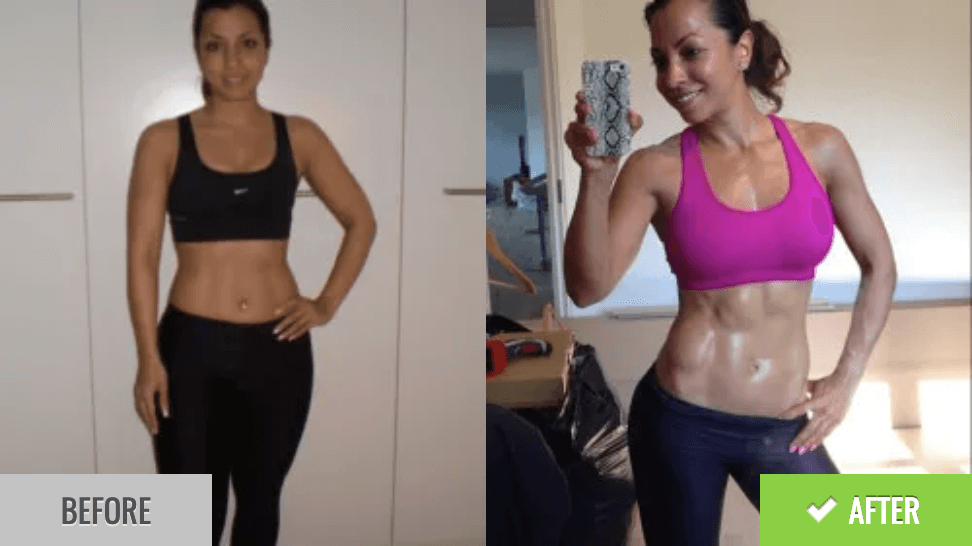
So, why do newbie gains occur?
Physiologically speaking, the reason muscle gain comes so easily early on is training dramatically spikes muscle protein synthesis rates, throwing your body’s muscle-building machinery into overdrive. Even better, it doesn’t take a particularly grueling workout to accomplish this, either.
As you spend more time in the gym, however, your body’s response to your workouts changes in a number of ways.
One of the more significant adaptations is muscle protein synthesis doesn’t remain elevated for as long after a workout, resulting in less muscle gain (it drops from two to three days, on average, to 12 to 24 hours).
You can find clear evidence of this phenomenon in a study conducted by scientists at the University of São Paulo.
The researchers reviewed five studies on the muscle protein synthesis response to training and found there’s a much greater and more prolonged spike in newbies than experienced lifters. You can see this difference clearly in this chart illustrating the relative increase in muscle protein synthesis after workouts:
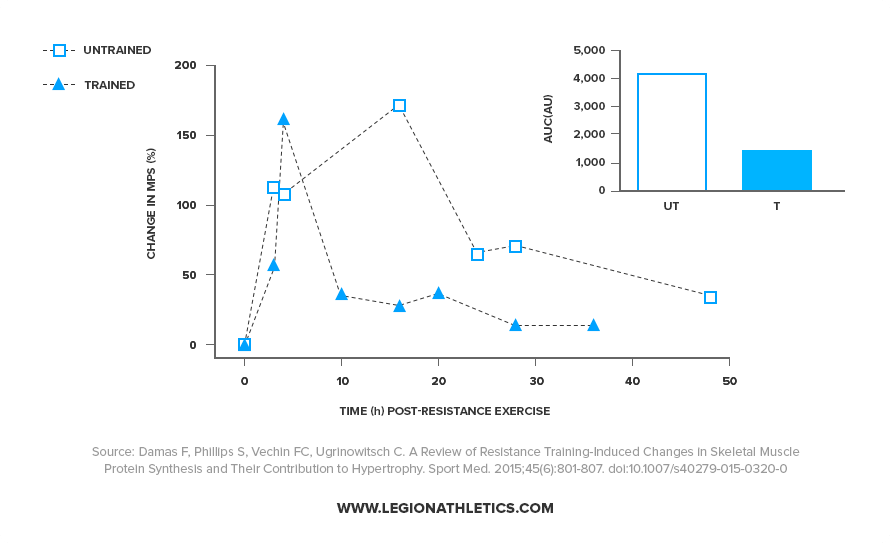
The square data points represent the untrained lifters and the triangles represent the trained lifters, so as you can see, the untrained lifters enjoyed far more muscle protein synthesis after training than the experienced ones.
You probably also noticed that while the trained participants were back to baseline around a day or so later, the untrained people were still building muscle after 50 hours following their workouts.
In several studies the researchers reviewed, it took three days for post-workout muscle protein synthesis to return to baseline in newbies.
To look at the data in another way, when you add up the total boost in protein synthesis both groups experienced in the hours after their workouts, the untrained lifters saw a 4,000 percent increase in muscle protein synthesis versus a 1,500 percent increase in the trained lifters.
Experienced weightlifters can compensate for this to some degree by doing more volume (sets or reps or both per week), which helps increase muscle protein synthesis, but it’ll never reach newbie levels again.
Moreover, you can also only increase your training volume so much before you run into injury, overtraining, and burnout.
Summary: Newbie gains refers to the rapid increase in muscle and strength that often occurs when people with little to no previous weightlifting experience start training intensively.
How Big of a Difference Do Newbie Gains Make?
Unfortunately, there isn’t much scientific research available on newbie gains, so we don’t have a pat answer to this question.
Furthermore, what little research we do have indicates that our ability to build muscle is highly variable.
For instance, in a study conducted by scientists at Indiana University, 585 untrained men and women did simple biceps workouts with their non-dominant arms for 12 weeks. The study doesn’t mention how often the subjects performed the workouts, but it was probably once per week.
The researchers recorded everyone’s strength as well as their biceps size using magnetic resonance imaging (MRI) before and after the 12-week study.
On average, everyone’s biceps grew about 19 percent and their biceps curl one-rep max increased 54 percent.
When you look at the individual data, though, you get a much clearer picture of just how much the individual response to weightlifting can vary.
Some people’s biceps got slightly smaller while one person’s grew 60 percent larger—three times the average—and some gained no strength to speak of whereas one person increased their biceps curl one-rep max by 250 percent.
So, while on average, everyone experienced a sharp and substantial uptick in biceps size and strength in response to the new stimulus of resistance training (newbie gains), some people enjoyed more and less benefit than others.
Now, while there’s a scarcity of high-quality published research on the matter, there is plenty of expert opinion based on decades of in-the-trenches experience and anecdotal evidence.
Two such experts worth consulting are Lyle McDonald and Alan Aragon.
Lyle McDonald’s Insights on Newbie Gains
Lyle McDonald is a writer, researcher, and the creator of BodyRecomposition.com, one of the best resources for evidence-based fitness knowledge on the net.
Here’s Lyle’s estimate of how much muscle you can gain in your first year of lifting:
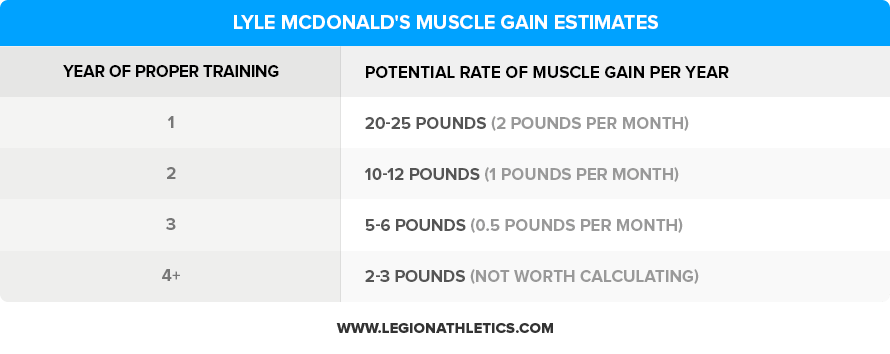
His formula is based on his extensive reading of the literature and experience helping thousands of people improve their body composition.
Based on what he’s read and seen, he estimates that guys can gain anywhere from 20 to 25 pounds of muscle (~2 pounds per month) in their first year of proper weightlifting. Keep in mind, that means 20 to 25 pounds of lean muscle tissue, not just 20 to 25 pounds of body weight.
As you can also see in the above chart, maximum muscle gain rapidly declines in each subsequent year, more or less halving with each trip around the sun.
Why is the first year so explosive? Newbie gains, of course.
Now, if 20 to 25 pounds of muscle gain in year one sounds low to you considering the numbers many beginners throw around, I understand. It’s not uncommon to hear claims of 40 to 50 pounds of muscle gain their first year of heavy training.
These people are mistaken.
They may have gained 40 to 50 pounds of body weight, but much of it wasn’t muscle mass but instead body fat as well as water and glycogen, much of which is stored in the muscles themselves.
And considering many newbies make a number of the mistakes we’ll cover in a few minutes, much of the weight they gain when they start out is just body fat.
Alan Aragon’s Insights on Newbie Gains
Alan Aragon is a published researcher and fitness author and coach who’s been designing diet and exercise programs for over 20 years.
Based on what he’s seen working with everyone from everyday gymgoers to Olympic athletes, most men can gain muscle at about this rate:
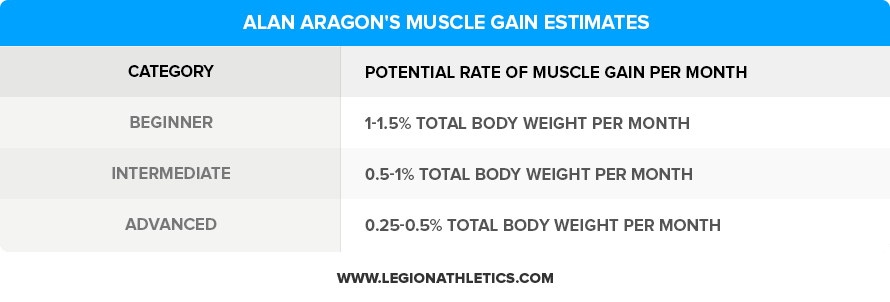
As you can see, Alan’s muscle-building model is based on gaining a percentage of your body weight per month.
Naturally, this is only accurate for people who are relatively lean to start with (around 10 to 15 percent body fat for men and 20 to 25 percent body fat for women). The more overweight someone is, the less muscle they’ll be able to gain relative to their total body weight.
Here’s an example to show how this formula works.
When I started lifting weights, I was around 155 pounds and 12 percent body fat. Based on Alan’s model, I could expect to gain about 1.4 to 2.1 pounds of muscle per month in my first year, which is right in line with Lyle’s conclusions as well.
As it turned out, I only gained about 10 pounds of muscle in my first year for reasons we’ll go over in a moment.
Mike Matthews’ Insights on Newbie Gains
Lyle and Alan’s models are accurate for most people who want to know what to expect when they start lifting weights.
Some people are looking for a more detailed answer, however, so if that’s you, let’s take a look at a slightly more involved but accurate formula for estimating your potential newbie gains.
This is based on Dr. Casey Butt’s frame-size model of muscle gain, which revolves around the premise that the size of your skeleton mostly determines how much muscle you can gain over your lifetime.
That may sound simplistic but it’s supported by good evidence, and in fact, is likely the most accurate method we currently have for estimating our potential for whole-body muscle gain.
(Click here to learn more about Dr. Butts’ research and model.)
Once you’ve determined approximately how much total muscle you’ll be able to gain, you can sketch out a roughly accurate roadmap of how your personal fitness journey will play out.
Based on my experience, I’ve found that if people do the most important things with their training and diet mostly right, they achieve 40 to 50 percent of their total lifetime potential for muscularity in year one.
In other words, in their first year, you can gain up to 50 percent of all the muscle you’ll ever gain regardless of how long and hard you train.
It’s probably worth noting that the bulk of first-year gains tend to come in the first six months of training, too.
For example, a guy with average genetics could expect to gain anywhere from 10 to 15 pounds of muscle in his first six months in the gym (~1.5 to 2.5 pounds per month) and then 5 to 10 pounds of muscle in the following six months (~1 to 1.5 pounds per month).
Then, in year two, you can gain about half the amount of muscle you gained in year one.
In year three, you can gain about half the amount of muscle you gained in year two, and each successive year more or less halves in this way until muscle gain becomes vanishingly small.
Here’s what this would look like in graph form:
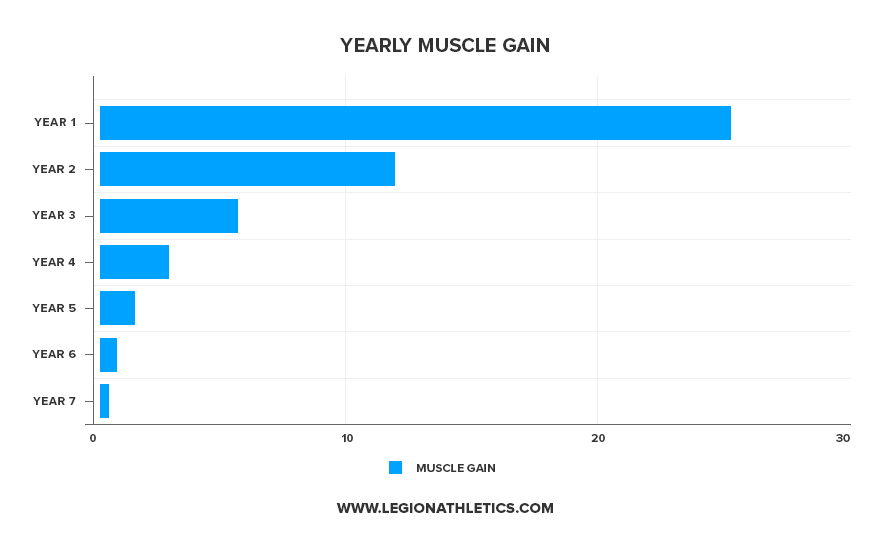
Let’s see how this plays out for me.
According to Butts’ research, the best body composition I could ever hope for is about 210 pounds at 10 percent body fat.
That’s likely a bit high and should be trimmed by about 5 percent, (for reasons I discuss here), which would lower my ceiling to the more plausible 199 pounds at 10 percent body fat (179 pounds of lean mass).
When I started lifting, I was about 155 pounds and 12 percent body fat (136 pounds of lean mass), so according to good evidence, my genetics can support about 43 pounds of total muscle gain.
Here’s how I looked:

Let’s arbitrarily round up my potential gains to 45 pounds of muscle because I’m ever the optimist, and see how that pencils out:
- Year one: 22 pounds of muscle gain
- Year two: 11 pounds of muscle gain
- Year three: 6 pounds of muscle gain
- Year four: 3 pounds of muscle gain
- Year five: 1.5 pounds of muscle gain
- Year six+: Negligible muscle gain
Total the numbers up and you get 43.5 pounds of total muscle gain, and to reach 45, it may take several more years.
Now, I didn’t have a damn clue what I was doing for the first seven years of gym-going, so by that point, I hadn’t gained more than 25 pounds of muscle.
Here’s how I looked:

I then got my act together, learned how to eat and exercise properly, and had a nice second-wind of muscle gain, which lasted 3 to 4 years.
Here’s what that looked like:
View this post on Instagram
I was 185 and about 7 percent body fat here, which works out to 172 pounds of lean mass and thus gives me around 7 more pounds of potential muscle gain.
From here, I continued to train hard and regularly but didn’t go into a calorie surplus for any extended period of time, and so expected little in the way of muscle growth.
Here I am a few years later:
View this post on Instagram
I weighed 188 pounds here and was again around 7 percent body fat (175 pounds of lean mass), indicating I had gained just 3 pounds of muscle in the three years or so in between these pictures.
And here’s me now, a couple of years after that shot at 192 pounds and approximately 10 percent body fat:
View this post on Instagram
Again, although I didn’t dedicate any serious time to lean bulking in between those last two pictures, I still trained hard and regularly yet only gained about a pound or so of muscle.
So it goes as you inch toward your physique’s finish line—you can keep making small improvements to your body composition, but they’re too small to measure or see in terms of weeks or even months.
Anyway, here’s what you need to do if you’re new to weightlifting and want to forecast your muscle-building journey:
- Weigh yourself and estimate your body fat percentage.
- Estimate your current total lean body mass by a) subtracting your body fat percentage from 100 percent and b) multiplying your body weight by the sum.
- Estimate how muscular you can get in your lifetime using the “Natural Muscular Potential Calculator” here.
- Estimate how much muscle you can gain by subtracting your current total lean body mass from your maximum predicted lean body mass.
- Create your timeline of muscle gain by assuming you can gain 50 percent of the amount calculated in step 4 in your first year of lifting, 50 percent of year one in year two, 50 percent of year two in year three, and so on.
Now, depending on who you follow online, those numbers—and much of what I’ve been discussing here, for that matter—may seem awfully pessimistic.
There’s no shortage of jacked dudes on the Gram who claim to have gained 30 to 40 pounds of pure muscle in their first year of training and who now, many years later, still add considerable amounts of muscle each and every year.
How can this be? Steroids, natch.
Not #hustleandgrind, #nodaysoff, #muhdadwasabodybuilder, or any other explanation or defense. Drugs. A lot of them.
That’s how you get and stay freakishly big (FFMI north of 25), lean (sub-10 percent body fat), and strong (1,500+ total), while continuing to gain more and more size and strength.
If you want to learn more about the real effects—and side effects—of steroids, check out these articles:
⇨ 6 Things You’ve Always Wanted to Know About Steroids
⇨ 8 Reliable (and Evidence-Based) Ways to Tell If Someone Is “Natty” or Not
⇨ This Is Everything You Need to Know About Trenbolone
⇨ What 35 Studies Say About Winstrol and Muscle Growth
⇨ The “Good” and “Bad” Reasons to Take Steroids
The same goes for guys (or gals) who, after several years of effective training and considerable muscle and strength gain, suddenly experience a second wind of newbie gains (rapid increase in size and strength).
No, it’s not the new diet, training program, or supplements. It’s the #dedication. All 10 grams of it they inject every week.
So, the point is this:
Don’t indiscriminately base your expectations for muscle and strength gain on what you see online.
Follow the advice in this article instead and you’ll find it much easier to get and stay motivated to continue putting in the work and much harder to fall prey to fitness predators who’d steal the pennies off a dead man’s eyes.
Summary: You can expect newbie gains to last about a year, with most of the benefits coming in the first six months of proper training. With the help of newbie gains, men can gain up to 20 to 25 pounds of muscle in their first year, and women can gain about half that.
Why Do Newbie Gains End?
We all know we can’t keep gaining muscle forever, but why not?
And why does muscle gain slow down so much after year one?
Why can’t we gain muscle and strength more or less at the same rate until reaching our genetic potential?
All good questions, and to get at the answers, let’s review a concept known as the repeated bout effect.
This simple principle states that the more you do a certain kind of exercise, the more your body becomes accustomed to it and the less adaptation is stimulated by it.
In other words, as you accumulate more training experience, you get less and less muscle and strength gain per unit of training effort.
When you think of exercise and muscle gain from an evolutionary perspective, this makes perfect sense.
Although muscle mass would’ve helped our ancestors survive by making them more effective hunters, gatherers, and fighters, it’s also a very “expensive” organ, requiring large amounts of protein, nutrients, and calories to maintain.
As early human ancestors often had to endure severe food shortages, we most likely evolved to use energy (calories) as efficiently as possible. Thus, the body is designed to build just enough muscle as necessary to complete the tasks at hand and no more.
Furthermore, evolution has apparently determined that for the purposes of general survival, we humans don’t generally need more than 30 to 50 pounds of additional muscle, which is about the limit of what most natural lifters can achieve.
Therefore, the closer you approach 30, 40, or 50 pounds of total muscle gain, the harder you’re going to have to work to “convince” your body to get any bigger.
Think of this in terms of physiological ROI. The positives of building muscle are things like greater strength, performance, etc., and thus survivability and the downsides are primarily the increased energy and nutritional needs.
When you’re new to lifting, every pound of muscle you gain brings a lot more positives than negatives, so your body readily builds more.
As you get more and more jacked, however, the functional utility of every additional pound of muscle declines exponentially but the drawbacks remain the same. Hence, the body becomes less and less willing to continue building more.
After this “honeymoon” phase is over, “the grind” begins, and the best you can hope for from this point on is to keep making small, incremental increases in muscle growth year to year.
If this has taken some of the wind out of your sails, don’t despair. Nothing worth having ever came easy, and everyone who’s ever built a great physique without using steroids has followed the same journey.
Summary: The reason newbie gains end is your body becomes less and less responsive to strength training due to the repeated bout effect, and builds less and less muscle for every additional unit of effort.
Can You Miss Out On Newbie Gains?
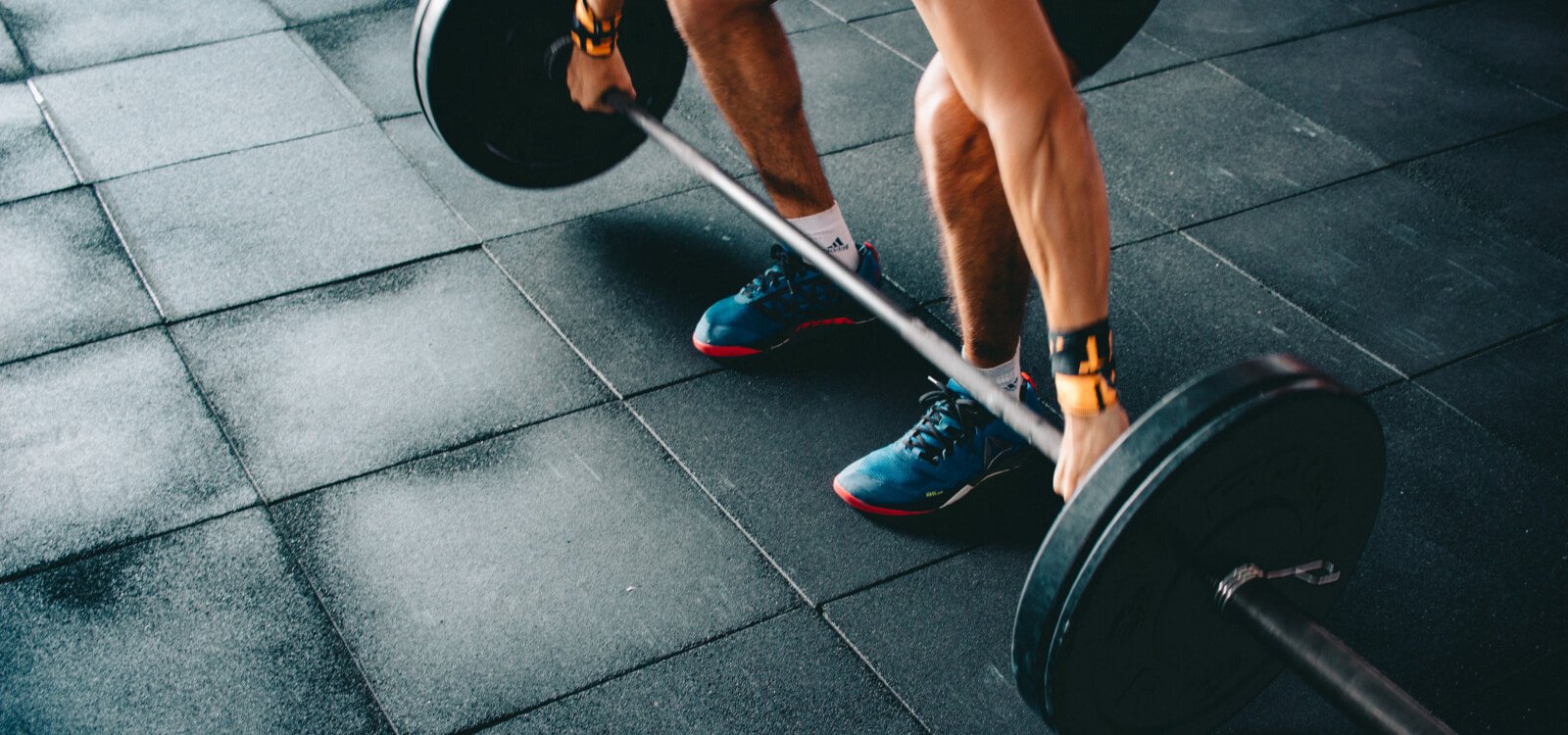
Some people believe that if you train and eat poorly during your first year of lifting, you can miss out on your newbie gains.
There’s a kernel of truth there, but it’s more wrong than right.
If you do a lot wrong during your first year of lifting, like I did, then you won’t gain as much muscle as you should.
For example, if you aren’t eating enough calories or protein, aren’t progressively overloading your muscles, or aren’t sleeping enough, you probably won’t build as much muscle in your first year as the formulas in this article would predict.
Some people continue to make these mistakes for months, years, and even decades, sometimes only realizing the error in their ways in their late thirties or early forties.
Once you hit that age, you aren’t going to be able to train as hard, heavy, or often as someone who’s younger, and you won’t build muscle as quickly. In other words, your newbie gains may be lost forever.
That said, it’s never too late to get into great shape and nobody should let something as trivial as a bit less potential muscle and strength gain stop them from building a body they can be proud of.
If you correct course at a younger age, though, like I did, then you can make newbie gains even after several years of regular weightlifting.
Summary: You can make newbie gains even after years of improper training and dieting.
What to Do When Your Newbie Gains Are Over
Many people become disheartened when they realize that after their first halcyon year of muscle building, the whole affair begins to resemble trench warfare: months of struggle to advance a few inches.
They simply need to change their perspective.
Where you once measured progress in pounds on the scale and bar, you now need to think in grams.
In other words, once you’ve made your way well into the intermediate phase of weightlifting, the rate of progress doesn’t matter as much as simply making progress.
And here’s the rule of thumb: as long as you’re getting stronger, you’re moving in the right direction.
Another important change you’re probably going to need to make is your program. Chances are, “what got you here probably won’t get you there.”
This mostly comes down to working harder in the gym for less reward by doing more hard sets per major muscle group per week while still pushing to get stronger (lift heavier weights).
You also need to become fastidious about your diet. For instance, you can get away with grossly overeating while lean bulking when you’re a newbie, but eventually all this does is make you fatter faster, which gets in the way of long-term muscle gain in a number of ways.
Likewise, you can get away with very low-calorie and even low-protein dieting as a beginner because you don’t have much muscle to lose. As you become more advanced, though, it also becomes harder to hold on to your hard-earned lean mass when you restrict your calories for fat loss.
So, here are five things to keep in mind as you move out of your beginner phase as a weightlifter:
1. Maintain a moderate calorie surplus of about 10 percent when lean bulking.
This should allow you to gain two to four pounds per month, which should be your goal after your newbie gains are finished.
Women should shoot for half this number: one to two pounds per month.
If you’re not sure how to determine your calorie intake, read this article:
This Is the Best TDEE Calculator on the Web (2019)
2. Eat around 1 gram of protein per pound of body weight per day.
This is enough to ensure you’re getting all of the benefits of a high-protein diet. There’s no need to eat more protein than this to build muscle.
If you want to know why, read this article:
How Much Protein You Should Eat to Build Muscle
3. Alternate between lean bulking and cutting phases until you’ve gained the size you want.
You can build muscle and lose fat at the same time, or “recomp,” when you first start lifting weights.
This becomes increasingly difficult as you become a more advanced lifter, though, and after your first year or two of lifting it’s a fool’s errand.
Here’s what you should do instead:
If you’re a guy and you’re over 15 percent body fat, cut down to about 10 percent before lean bulking. If you’re a woman and over 25 percent body fat, cut down to about 20 percent before lean bulking.
Once you’ve reached 10 or 20 percent body fat, maintain a moderate calorie surplus until you reach about 15 percent (men) or 25 percent (women) body fat, and repeat this process of gaining muscle and losing fat until you’ve reached the size you want.
Read this article to learn how to lose fat without losing muscle:
⇒ The Complete Guide to Safely and Healthily Losing Weight Fast
And this one to learn how to build muscle while minimizing fat gain:
⇒ The Best Way to Gain Muscle Without Getting Fat
4. Emphasize progressive overload in your training above all else.
Progressive overload refers to increasing the amount of tension your muscles produce over time.
The most effective way to do this is increasing the amount of weight that you’re lifting over time (adding weight to the bar).
In other words, the key to gaining muscle and strength isn’t “muscle confusion,” special exercises, balancing on a BOSU ball, or seeing how much you can sweat on everything in the gym.
It’s making your muscles work harder over time.
And this is exactly what you do when you gradually force them to handle heavier and heavier weights.
Read this article to learn more about how strength training programs can help you get bigger and stronger:
The 12 Best Science-Based Strength Training Programs for Gaining Muscle and Strength
5. Consider taking supplements to increase muscle gain.

I saved this for last because, quite frankly, it’s far less important than proper diet and training.
You see, supplements don’t build great physiques—dedication to proper training and nutrition does.
Unfortunately, the workout supplement industry is plagued by pseudoscience, ridiculous hype, misleading advertising and endorsements, products full of junk ingredients, underdosing key ingredients, and many other shenanigans.
Most supplement companies produce cheap, junk products and try to dazzle you with ridiculous marketing claims, high-profile (and very expensive) endorsements, pseudo-scientific babble, fancy-sounding proprietary blends, and flashy packaging.
So, while workout supplements don’t play a vital role in building muscle and losing fat, and many are a complete waste of money . . . the right ones can help.
The truth of the matter is there are safe, natural substances that have been scientifically proven to deliver benefits such as increased strength, muscle endurance and growth, fat loss, and more. (And if you’d like to know exactly what supplements to take to reach your fitness goals, take the Legion Supplement Finder Quiz.)
For the purpose of this article, let’s just quickly review the supplements that are going to help you build muscle as quickly as possible and make the most of your newbie gains.
Creatine
Creatine is a substance found naturally in the body and in foods like red meat. It’s perhaps the most researched molecule in the world of sport supplements—the subject of hundreds of studies—and the consensus is very clear:
Supplementation with creatine helps . . .
You may have heard that creatine is bad for your kidneys, but these claims have been categorically and repeatedly disproven. In healthy subjects, creatine has been shown to have no harmful side effects, in both short- or long-term usage. People with kidney disease are not advised to supplement with creatine, however.
If you have healthy kidneys, I highly recommend that you supplement with creatine. It’s safe, cheap, and effective.
In terms of specific products, here’s what I recommend:
If you want a simple creatine supplement that mixes well with a drink, try micronized creatine monohydrate.
If you’d prefer not to have to measure, mix, and drink your creatine, try creatine gummies.
Or, if you’d like a creatine supplement that contains other ingredients to maximize your recovery, try a post-workout supplement like Recharge.
Protein Powder
You don’t need protein supplements to gain muscle, but, considering how much protein you need to eat every day to maximize muscle growth, getting all your protein from whole food can be impractical.
That’s the main reason I take casein and whey protein supplements.
Whey+ is 100% naturally sweetened and flavored whey isolate that is made from milk sourced from small dairy farms in Ireland, which are known for their exceptionally high-quality dairy.
I can confidently say that this is the creamiest, tastiest, healthiest all-natural whey protein powder you can find.
Casein+ is 100% naturally sweetened and flavored casein isolate also made from milk sourced from small dairy farms in Ireland.
In terms of which protein powder to choose, you can’t go wrong either way.
Casein digests slightly slower than whey, providing a steady stream of amino acids to the muscles for growth and repair, which some experts believe may make it a better choice for building muscle.
Whey, on the other hand, is digested faster and produces a more rapid rise in amino acid levels, which some experts think might enhance post-workout muscle growth more than other forms.
This doesn’t mean you need to have whey after you work out, though. The most important thing is simply eating enough protein every day.
Pre-Workout Drink
There’s no question that a pre-workout supplement can get you fired up to get to work in the gym. There are downsides and potential risks, however.
Many pre-workout drinks are stuffed full of ineffective ingredients and/or minuscule dosages of otherwise good ingredients, making them little more than a few cheap stimulants with some “pixie dust” sprinkled in to make for a pretty label and convincing ad copy.
Many others don’t even have stimulants going for them and are just complete duds.
Others still are downright dangerous, like USPLabs’ popular pre-workout “Jack3d,” which contained a powerful (and now banned) stimulant known as DMAA.
Even worse was the popular pre-workout supplement “Craze,” which contained a chemical similar to methamphetamine.
The reality is it’s very hard to find a pre-workout supplement that’s light on stimulants but heavy on natural, safe, performance-enhancing ingredients like beta-alanine, betaine, and citrulline.
And that’s why we sell our own pre-workout supplement. It’s called Pulse and it contains six of the most effective performance-enhancing ingredients available:
- Caffeine
- Theanine
- Beta-alanine
- Citrulline malate
- Betaine
- Alpha-GPC
The bottom line is if you want to know what a pre-workout is supposed to feel like and want to experience the type of energy rush and performance boost that only clinically effective dosages of scientifically validated ingredients can deliver, you want to try Pulse.
Again, if you feel confused about what supplements you should take to reach your goals, take the Legion Supplement Finder Quiz to learn exactly what supplements are right for you. It’s the best way to ensure you get the most out of your supplement regimen.
The Bottom Line on Newbie Gains
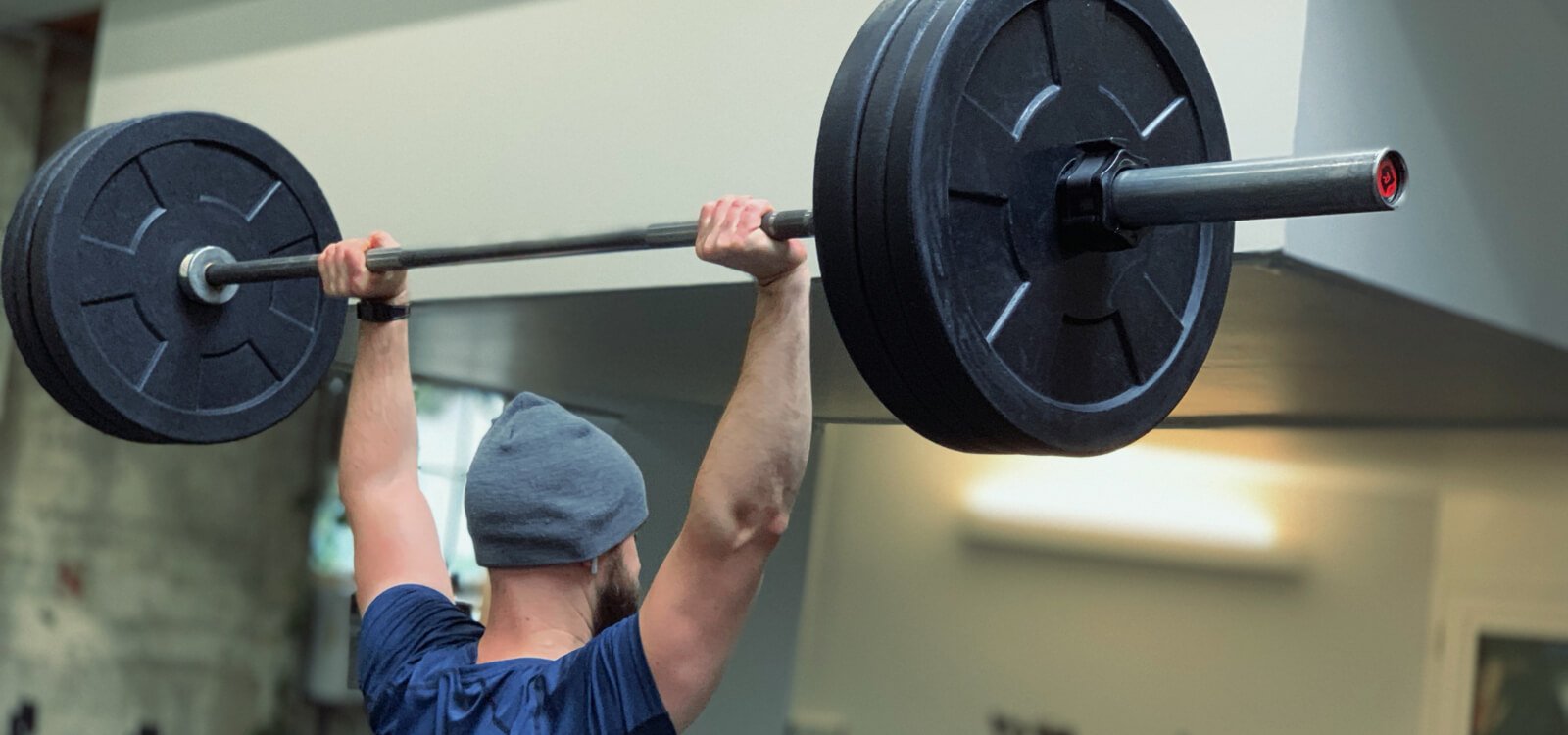
Newbie gains refer to the rapid increase in muscle mass that occurs when people with little to no previous weightlifting experience start lifting weights.
It’s also less commonly seen among experienced weightlifters who simply haven’t made much progress for any number of reasons.
In both cases, the muscles are hypersensitive to the effects of effective resistance training and rapidly grow in response.
A good rule of thumb is both men and women can gain about 1 to 1.5 percent of their body weight per month on average during their first year of weightlifting, with slightly faster muscle gain occurring in the first six months of proper training than the following six.
Assuming they’re doing most of the most important things in the kitchen and gym mostly right, men can gain up to 20 to 25 pounds of muscle in their first year of effective lifting, and women can gain about half this amount.
Newbie gains slow down considerably after about 6 months of lifting, and they’re more or less gone within 12 months.
The reason for this is that the closer you get to your genetic potential for muscle gain, the harder it is to continue gaining muscle.
Although you may have gained considerably less muscle than you could’ve in your first year of lifting due to diet or training mistakes, you probably haven’t “missed out” on your newbie gains.
Chances are you’ll experience rapid improvements in your body composition if you start doing things correctly.
Once your newbie gains are behind you, there are five things you can do to maximize your results going forward:
- Maintain a moderate calorie surplus of about 10 percent when lean bulking.
- Eat around 1 gram of protein per pound of body weight per day.
- Alternate between lean bulking and cutting phases until you’ve gained the size you want.
- Emphasize progressive overload in your training above all else.
- Consider taking supplements, such as creatine, protein powder, and a pre-workout drink, to increase muscle gain.
Do that, and you’ll continue to gain strength and muscle for years to come. Until one day, there’s finally nothing left to gain.
Happy lifting!
***
This article is from the second edition of my bestselling fitness book for experienced weightlifters, Beyond Bigger Leaner Stronger, which is now live everywhere you can buy books online. Click here to learn more.
What’s your take on newbie gains? Have anything else to share? Let me know in the comments below!
Scientific References +
- Francaux, M., & Poortmans, J. R. (2006). Side effects of creatine supplementation in athletes. In International journal of sports physiology and performance (Vol. 1, Issue 4, pp. 311–323). https://doi.org/10.1123/ijspp.1.4.311
- Is the use of oral creatine supplementation safe? - PubMed - NCBI. (n.d.). Retrieved May 7, 2020, from https://www.ncbi.nlm.nih.gov/pubmed/15758854
- Poortmans, J. R., & Francaux, M. (2000). Adverse effects of creatine supplementation: Fact or fiction? In Sports Medicine (Vol. 30, Issue 3, pp. 155–170). Adis International Ltd. https://doi.org/10.2165/00007256-200030030-00002
- Eckerson, J. M., Stout, J. R., Moore, G. A., Stone, N. J., Iwan, K. A., Gebauer, A. N., & Ginsberg, R. (2005). Effect of creatine phosphate supplementation on anaerobic working capacity and body weight after two and six days of loading in men and women. Journal of Strength and Conditioning Research, 19(4), 756–763. https://doi.org/10.1519/R-16924.1
- Branch, J. D. (2003). Effect of creatine supplementation on body composition and performance: A meta-analysis. International Journal of Sport Nutrition and Exercise Metabolism, 13(2), 198–226. https://doi.org/10.1123/ijsnem.13.2.198
- Thrifty Gene Hypothesis - an overview | ScienceDirect Topics. (n.d.). Retrieved May 7, 2020, from https://www.sciencedirect.com/topics/medicine-and-dentistry/thrifty-gene-hypothesis
- McHugh, M. P. (2003). Recent advances in the understanding of the repeated bout effect: The protective effect against muscle damage from a single bout of eccentric exercise. In Scandinavian Journal of Medicine and Science in Sports (Vol. 13, Issue 2, pp. 88–97). https://doi.org/10.1034/j.1600-0838.2003.02477.x
- Variability in muscle size and strength gain after unilateral resistance training | Request PDF. (n.d.). Retrieved May 7, 2020, from https://www.researchgate.net/publication/7794282_Variability_in_muscle_size_and_strength_gain_after_unilateral_resistance_training
- MacDougall, J. D., Gibala, M. J., Tarnopolsky, M. A., MacDonald, J. R., Interisano, S. A., & Yarasheski, K. E. (1995). The time course for elevated muscle protein synthesis following heavy resistance exercise. Canadian Journal of Applied Physiology, 20(4), 480–486. https://doi.org/10.1139/h95-038
- Damas, F., Phillips, S., Vechin, F. C., & Ugrinowitsch, C. (2015). A Review of Resistance Training-Induced Changes in Skeletal Muscle Protein Synthesis and Their Contribution to Hypertrophy. In Sports Medicine (Vol. 45, Issue 6, pp. 801–807). Springer International Publishing. https://doi.org/10.1007/s40279-015-0320-0
- Cohen, P. A., Travis, J. C., & Venhuis, B. J. (2014). A methamphetamine analog ( N,α -diethyl-phenylethylamine) identified in a mainstream dietary supplement. Drug Testing and Analysis, 6(7–8), 805–807. https://doi.org/10.1002/dta.1578
- Ho, J. Y., Kraemer, W. J., Volek, J. S., Fragala, M. S., Thomas, G. A., Dunn-Lewis, C., Coday, M., Häkkinen, K., & Maresh, C. M. (2010). L-Carnitine l-tartrate supplementation favorably affects biochemical markers of recovery from physical exertion in middle-aged men and women. Metabolism: Clinical and Experimental, 59(8), 1190–1199. https://doi.org/10.1016/j.metabol.2009.11.012
- Bassit, R. A., Pinheiro, C. H. D. J., Vitzel, K. F., Sproesser, A. J., Silveira, L. R., & Curi, R. (2010). Effect of short-term creatine supplementation on markers of skeletal muscle damage after strenuous contractile activity. European Journal of Applied Physiology, 108(5), 945–955. https://doi.org/10.1007/s00421-009-1305-1
- McClave, S. A., & Snider, H. L. (2001). Dissecting the energy needs of the body. In Current Opinion in Clinical Nutrition and Metabolic Care (Vol. 4, Issue 2, pp. 143–147). https://doi.org/10.1097/00075197-200103000-00011
- Schoenfeld, B. J., Ogborn, D., & Krieger, J. W. (2017). Dose-response relationship between weekly resistance training volume and increases in muscle mass: A systematic review and meta-analysis. Journal of Sports Sciences, 35(11), 1073–1082. https://doi.org/10.1080/02640414.2016.1210197
- Wernbom, M., Augustsson, J., & Thomeé, R. (2007). The influence of frequency, intensity, volume and mode of strength training on whole muscle cross-sectional area in humans. In Sports Medicine (Vol. 37, Issue 3, pp. 225–264). https://doi.org/10.2165/00007256-200737030-00004










